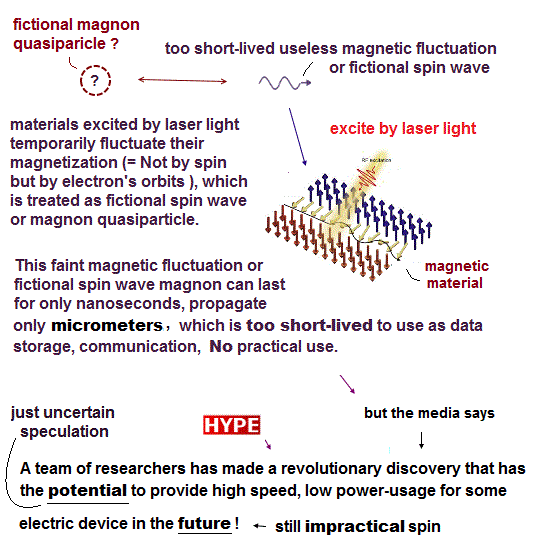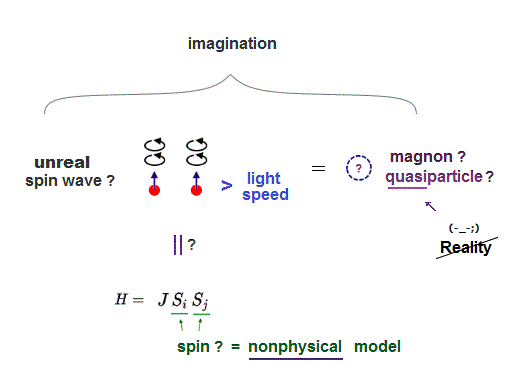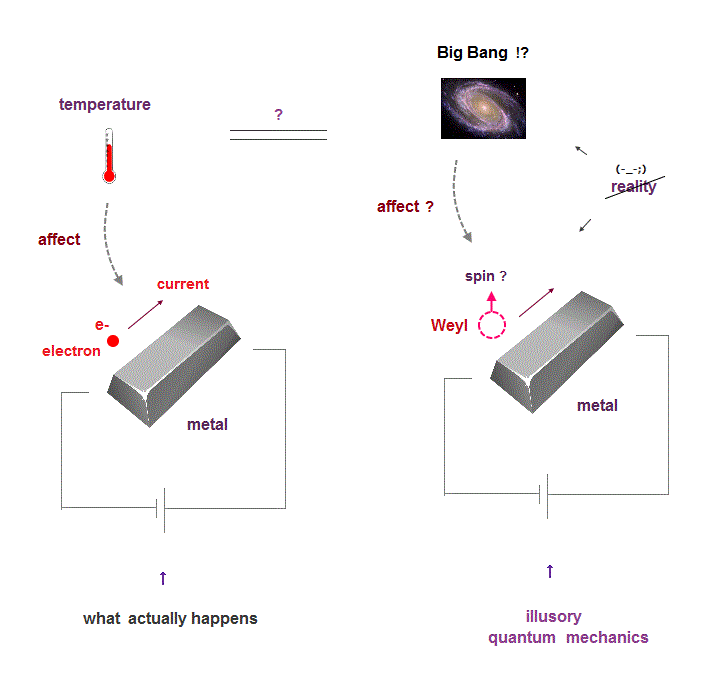
Home page
Spintronics doesn't use spin
Fake magnon news
(Fig.1) No progress. Despite extremely longtime researches wasting money, spin wave = quasiparticle magnon has been useless since 1930s

Spin wave expressed as fictional magnon quasiparticle is just a very unstable, ultra-short-lived magnetic fluctuation (= consisting of electron's orbits, Not of unphysical spin ) in magnetic material excited by laser light (= microwave pulse antenna ) under external magnetic field ( this-p.2-4 ).
This (unreal) spin wave (= fictional magnon quasiparticle ) is useless, extremely short-lived (= spin wave's lifetime is only nanoseconds, this-2nd~3rd-paragraphs ), propagating only micrometers ( this-abstract, this-p.3-Table I ), which cannot be used as stably memories, switches nor sending information.
This-p.1-left- says "However, the utilisation of magnons in magnonic applications can be
↑ The unreal electron spin is unmeasurable in all the spin wave experiments that just measure the oscilloscope (= electric current vibration ) or magnetization change as a sign of the fictional spin wave or magnon quasiparticle, which is also detected as the polarization change of light reflected by magnetic material or by using magnetic force microscopes ( this-p.2-right ). ← All of these instruments for spin wave are too bulky to be practical.
Despite extremely long years of fruitless researches (= since 1930s ) and the media-hype, this spin wave (= fictional magnon quasiparticle ) is still useless, with No practical application ( This-challenges 3/22/2025 ), which fact proves spin wave or magnon can never be put to practical use.
(Fig.1') There is a wide discrepancy between overhyped fake news and actual papers.

The 1st paragraph of another overhyped news (5/22/2025) says
"which processes information using magnons (spin waves)... and be applicable in various fields such as next-generation neuromorphic (brain-mimicking) computing structures"
↑ This research paper's abstract says nothing about any practical use such as hyped neuromorphic computers, contrary to the above hyped news.
↑ This research (= p.2-5) is just about impractical theory with No experiment, and tried to express fictional magnon quasiparticle only as unphysical abstract math symbols with No real particle shape.
The 4th and 2nd-last paragraphs of this overhyped news (5/15/2025) say
"When electrons dance in a coordinated manner, their movements create waves called magnons (= fictional quasiparticle )"
"This could (= just speculation, still useless ) lead to faster data processing, reduced energy consumption and longer battery life for everyday electronics such as smartphones, computers and wearable devices"
↑ This research paper ↓
p.1-abstract-last says "Our experimental findings introduce a strategy for controlling magnons and underscore the need for further theoretical studies to better understand the underlying microscopic interactions between magnons and phonons." ← No mention of any practical use such as smartphone, computers, contrary to the above overhyped fake news.
p.1-right-1st-paragraph says
"Nevertheless, effectively
guiding and coherently manipulating magnons using external stimuli
is still a significant challenge" ← manipulating magnon quasiparticle or spin wave is still impossible
The 4th, 12th paragraph of this overhyped news (6/12/2025) says
"When these spins all move together, they create a wave or "excitation" called a magnon (= fictional quasiparticle )"
" Their approach could (= just speculation ) open new ways of processing information using magnons, with implications for the development of quantum computers" ← false
↑ This research paper ↓
p.1-abstract (or this-abstract ) says nothing about quantum computers, contrary to the above hyped news.
↑ p.2-Fig.1, p.3-Fig.2 ~Fig.3 shows this research just excited some magnetic vibration on some bulky material (= ~mm ) by antenna microwave pulse, and this vibration interference (= fictional magnon quasiparticle ? = undetectable ) was measured by the output (classical) oscilloscope.
↑ So this research has nothing to do with quantum computers, any practical application or fictional magnon quasiparticle (= spin wave ).
(Fig.2) Magnon is useful for neuromorphic computers ! is overhyped fake news.

Despite an incredible amount of overhyped fake news, spin wave (= fictional magnon quasiparticle ) is useless for any technologies such as computers ( this-challenges, 3/22/2025 )
This-p.17(p.16)-computing with manonics-current and future challenges (or this-p.18. in 2024 ) say
"Therefore, it remains a challenge to develop
an on-chip method for short-wavelength spin-wave excitation
with high efficiency"
"an integrated magnonic circuit containing multiple logic gates and suitable for further cascading has Not yet been experimentally demonstrated"
The 2nd, 5th-paragraphs of this hyped news (2/4/2025) say
"this innovation marks a transformative advance in unconventional computing, with significant potential (= still unrealized ) for next-generation telecommunications, computing, and neuromorphic systems." ← hype
"built a unique experimental setup using 49 individually controlled current loops on an yttrium-iron-garnet (YIG) film. These loops created tunable magnetic fields to control and manipulate magnons."
↑ This above research paper ( this ↓ )
p.3-Fig.1, p.5-Fig.3, p.6-Fig.4 show they applied various controllable electric currents to 49 omega-shaped loops (= each loop is bulky, very big = 1.1mm, = Not a computer, this-p.5 ) to generate various magnetic field, and then input microwave pulses whose transmission (= modified by 49 magnetic field loops ) was measured by output detectors. ← That's all. No computers nor magnon quasiparticles.
↑ p.9-left-last~right says "In this manuscript, we report the realization of only linear functionalities. However, it is important to note that many tasks, such as neuromorphic computing or logic gates, inherently require the nonlinear regime and cannot be achieved in a linear system." ← neuromorphic computing cannot be achieved after all.
↑ This device (= just measuring the excited microwave or magnetic pulse lacking long-term storing memories ) is too big, too bulky (= one omega-shaped magnetic loop is 1.1mm ( this-p.6-left ), which is completely impractical, far bigger than today's practical DRAM compact memory bit of less than 50nm ), which bulky fictional magnon device can never be a practical (neuromorphic) computer.
↑ Actually, the 2nd-last-paragraph of this site about this same bulky magnon device says
"it has several drawbacks, ..The demonstrator is big and consumes a lot of energy"
↑ The fictional spin wave or magnon quasiparticle is useless, bulky, energy-inefficient with No practical application, contrary to a lot of hypes.
The 1st, 3rd-last paragraphs of this hyped news (3/29/2023)
"A magnon corresponds to the specific amount of energy required to change the magnetization of a material via a collective excitation called a spin wave."
"Now that we have shown that spin waves write data by switching the nanomagnets from states 0 to 1, we need to work on a process to switch them back again" ← This spin wave (= magnon quasiparticle ) switch is useless, unable to change 1 bit state back to 0.
↑ This research paper ↓
p.2-Fig.1 shows this magnon bit is impractical, too big (= one magnon bit size is bigger than 25μm, which is much bulkier than today's ordinary memory's bit of less than 50nm ).
p.1-right~p.2 says they applied electromagnetic wave (= VNA ), which causes magnetic vibration (= fictional spin wave or magnon quasiparticle ) under applied magneic field (= H ), which travelled 25μm, and flipped the direction of magnetization of some nanostripes (= bit change 0 → 1 ).
↑ The above research's Reviewer-p.3-#3-last said
"1. The authors emphasize too much on the low power consumption of their devices. The magnetic
fields (= H ) are still needed in the demonstration. They are suggested not to oversell it.
2... However, the size of the devices is still too large"
↑ So this so-called magnon computer's bit is impractical, too bulky (= one bit is more than 25μm ), whose operation needs many bulky instruments such as the electromagnetic wave emitter, the magnetic wave reader, external magnetic field generator and spin wave path (= for each bit )...
↑ This magnetic fluctuation (= spin wave magnon ) is neutral, inconvenient, which can Not be controlled freely nor directed to some specific positions like ordinary memory bits based on electric charges.
↑ Even one bit of (bulky) magnon bit can Not be controlled (= they just randomly flipped the magnetization of some part of the material from 0 to 1, Not from 1 to 0 ), which is completely useless for any technologies such as overhyped neuromorphic computers.
(Fig.3) Physicists just artificially fit parameters to experiments without quantum mechanical calculation nor prediction of fictional spin wave or magnon quasiparticle.

Quantum mechanics unable to describe atoms as real objects has to express this (fictitious) spin wave or magnon quasiparticle as nonphysical math symbols with No concrete shape ( this p.2, this p.9-(55) ).
Furthermore, quantum mechanics cannot predict the behavior of this spin wave, so there is No theoretical evidence of electron spin.
In order to describe this spin wave, physicists have to rely on classical Landau-Lifshitz-Gilbert (= LLG ) equation ( this p.6(or p.3)-1st-paragraph ) with artificially-chosen parameters such as damping parameter α which must be fit to experiments ( this p.11,15, this p.7-left, this p.67(or p.60)-4th-paragraph ) without quantum mechanical prediction.
This p.4-2nd-last-paragraph says
"The damping parameter is
generally set to suit the needs of the experiment. We have used an experimental value for bcc iron and
fcc cobalt as a reference when choosing α"
(Fig.4) Deadend spintronics needs to create overhyped fake news.

The 1st, 4th, 5th paragraphs of this hyped news (7/9/2025) say
"find energy-saving solutions for AI hardware. One promising idea is the use of so-called spin waves to process information" ← overhyped, fake.
"If an alternating current is applied to a magnetic material with an antenna, thereby generating a changing magnetic field, the spins in the material can generate a spin wave (= just magnetic fluctuation irrelevant to unreal spin )."
"Spin waves have already been used to create individual components, such as logic gates that process binary input signals into binary output signals" ← false, spin wave is completely useless.
↑ This research paper ↓
p.1-abstract says nothing about AI-hardware, contrary to the above hyped news.
p.6-left-1st-paragraph says ". In Fig.6 we present the spin-wave amplitude determined from a Faraday rotation image of the large-scale network, which shows propagation across the entire network with a total length of 185µm"
↑ So this experiment just generated unstable magnetic fluctuation (= spin wave ? ) which propagated just 185μm, which was detected as the incident light's polarization changed by the material's transient magnetization (= or spin wave ) called classical Faraday's effect.
↑ So this spin wave or magnetic fluctuation propagating just short distance is useless, irrelevant to AI or energy-efficient computers, contrary to hypes.
The 1st, 3rd, 4th paragraphs of this hyped news (7/24/2025) say
"For the first time, spin waves, also known as magnons, have been directly observed at the nanoscale. This breakthrough was made possible by combining a high–energy-resolution electron microscope with a theoretical method"
"The magnetism of materials such as iron and nickel is a consequence of tiny magnets.. so-called atomic spins (= false, electron spin is unreal, replaceable by real orbital motion ). In these magnetic materials, the spins in different atoms dance together in a synchronized motion called spin waves or magnons."
"Magnonics (= fictional spin wave quasiparticle ) has the potential (= just speculation, still useless ) to drive the next generation of electronics, offering faster, smaller, and more energy-efficient technology compared to today's charge-based systems." ← fake news.
↑ This research paper ↓
p.1-abstract-last just vaguely says ". This marks a milestone in magnonics and presents exciting opportunities for the development of spintronic devices" ← No mention of "faster, smaller, more energy-efficient technology", contrary to the above hyped fake news.
p.5-right-2nd-paragraph says "we can expect to detect one electron scattered by magnons only every 1–2 s,.. This may limit the ability to differentiate magnon dispersions" ← Very slow electron microscope's observation of spin wave or magnon.
p.7-right-2nd-paragraph says ", corresponding to a total of 2 h acquisition time." ← Each observation of (fictional) spin wave or magnon quasiparticle by this electron microscope took 2 hours, which is too slow, completely impractical as devices, contrary to the above hyped news of "faster technology !".
p.8-right says this research used one-pseudo-electron DFT model with artificially-chosen pseudo-potential with No quantum mechanical prediction.

Feel free to link to this site.